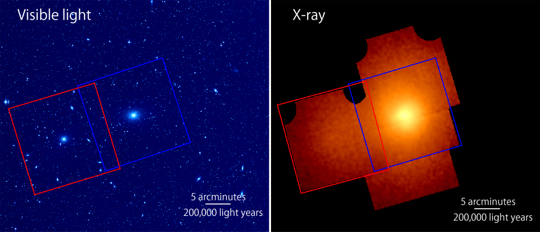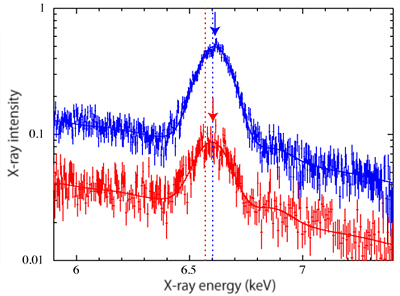Exploring the evolution of galaxy clusters dominated by the enigma of dark matter
 [Release: December, 2016]
[Release: December, 2016]
Associate professor Naomi Ota
Course of Physics
Department of Physics and Mathematics
Nara Women's University
Beyond the sky that we can see, lies the vast expanse of the universe. The study of astrophysics involves trying to solve mysteries such as, "how did this universe evolve and become what it is like now?", or, "how were celestial bodies such as galaxies born and how did they evolve in the ever expanding universe?" I have been studying large groups of galaxies (called galaxy clusters), which are said to be the largest celestial bodies in the universe, and have been conducting observations using artificial satellites and terrestrial telescopes. By studying the nature of the gas and the mysterious non-light emitting substance contained in galaxy clusters, and by measuring the mass of dark matter, I have been investigating the birth and evolution of galaxy clusters. It is my endeavor to accumulate sufficient data to be able to unravel the mystery of the evolution of the universe that is filled with dark matter and dark energy.
• What is a galaxy cluster?
When observed in visible light, a galaxy cluster appears as a group of 100 to 1000 galaxies held together by their mutual gravitational attraction (Fig. 1, left). The spread of this cluster extends to about 10 million light-years. However, when observed in X-ray wavelengths, which is invisible to the human eye, its appearance changes dramatically. The space between the galaxies is filled with very hot gas, whose temperature exceeds tens of millions of degrees, and covers the entire cluster of galaxies (Figure 1, right). The reason why this many galaxies and hot gases remain together without getting scattered is because there is a large amount of dark matter in the galaxy cluster (with a mass 1014 to 1015 times that of the Sun), and it is possible that its gravity keeps the galaxies and gases anchored.
If you ask whether a galaxy cluster is a special celestial body, well, it is not. Our own galaxy is said to belong to part of the Virgo supercluster of galaxies, and over 10000 clusters of galaxies have been discovered, including distant objects. Thus, the presence of galaxy clusters is commonplace in the universe, and knowing their evolution is an important clue to knowing the evolution of the entire universe.
• Results of recent observations - high-velocity gas movement in a galaxy cluster
As already mentioned, a galaxy cluster is made up of galaxies, hot gases, and dark matter. Such a galaxy cluster is also believed to attain a static state with the pressure of the hot gases being balanced by the gravity of the dark matter, once sufficient time has elapsed after its birth. This is somewhat similar to the soup that settles down after a period of time after being vigorously poured into a bowl. However, recent observations have revealed that galaxy clusters are dynamic celestial bodies. Figure 2 shows an example of the X-ray spectral data of a galaxy cluster acquired by the satellite "Suzaku." The signal from the iron contained in the hot gas is clearly visible. If its energy is measured precisely, we can determine the movement of the high-velocity gas using the Doppler effect. As a result of investigating several celestial bodies using this method, it was discovered that the gases in a galaxy cluster could collectively move at speeds as high as 1000 kilometers per second.
This implies that the static image described above may not necessarily hold. A galaxy cluster attracts smaller celestial bodies from its surroundings through the gravity of dark matter and grows through repeated mergers. This growth is taking place even in the present universe, some ten billion years after the birth of the celestial body, and is probably at the stage in which the rapid and complex movement of the gas flowing into the bowl of dark matter is continuing.
• Future prospects
Earlier this year, the satellite "Hitomi" was launched, equipped with a microcalorimeter detector that can measure the X-ray energy radiated by a celestial body with an accuracy as high as 30 times that of conventional CCD detectors. Leaving the detailed descriptions of these initial observation results to the homepage and to papers, we regard the elucidation of the movement of gas in galaxy clusters and the formation and evolution of these clusters as being among the important themes of space observation. With large-scale X-ray observation satellites being planned for the future, we can expect further progress in this area of research.

Fig. 1: Visible-light image (left) and X-ray image (right) of the Centaurus galaxy cluster.
One side of the figure corresponds to about 2.3 million light-years. The figure on the left is courtesy of the ESO Digitized Sky Survey. The figure on the right has been created from data obtained by the "Suzaku" satellite.

Figure 2: X-ray spectrum of the Centaurus galaxy cluster observed by the "Suzaku" satellite. The horizontal axis represents the X-ray energy and the vertical axis represents the intensity as a function of energy. The data of the areas enclosed by blue and red squares in Fig. 1 are represented by blue and red crosses, respectively. The peak (indicated by the arrow) at approximately 6.6 keV is the emission line radiation from iron. The iron emission lines of the two regions were found to have almost identical X-ray energy. However, in the area enclosed in red, there is some deviation in X-ray energy compared with the energy expected from the galaxies (dotted lines). This leads us to believe that collisions between galaxy clusters must have occurred in the past, resulting in the gases gaining speeds of several thousands of kilometers per second.
Recent articles
Naomi Ota & Hiroko Yoshida, "Search for gas bulk motions in eight nearby clusters of galaxies with Suzaku", Publications of the Astronomical Society of Japan, Volume 68, Issue SP1, id. S19 14pp. (2016)
http://pasj.oxfordjournals.org/content/68/SP1/S19
Hitomi Collaboration, "The quiescent intracluster medium in the core of the Perseus cluster", Nature, Volume 535, Issue 7610, pp. 117-121 (2016)
http://www.nature.com/nature/journal/v535/n7610/full/nature18627.html

